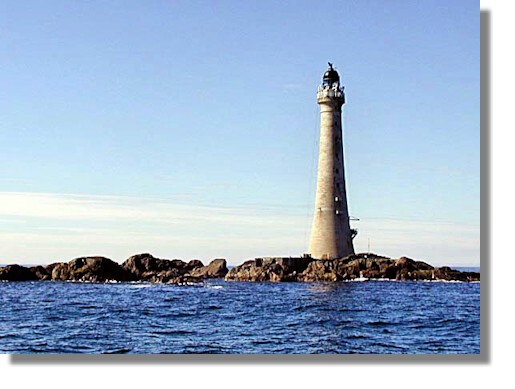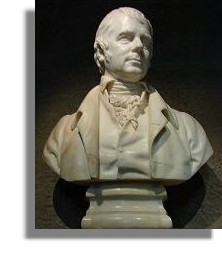

Lighthouse Beacons from Scotland
Skerryvore Lighthouse

Photo of Skerryvore Lighthouse via Wikimedia
Skerryvore (from the Gaelic An Sgeir Mhòr meaning "The Great Skerry") is a remote reef that lies off the west coast of Scotland, 12 miles (19 kilometres) south-west of the island of Tiree. The lighthouse on the skerry was built with some difficulty between 1838 and 1844 by Alan Stevenson.
Between 1790 and 1844 more than thirty ships were known to have been wrecked in the area. Robert Stevenson, chief engineer of the Northern Lighthouse Board (NLB) landed on the reef in 1804 and reported on the need for a beacon of some kind there. In 1814 he returned in the company of Sir Walter Scott and a party of Northern Lighthouse Board Commissioners. Scott wrote:
"Quiet perseverance on the part of Mr S, and great kicking, bouncing and squabbling upon that of the yacht, who seems to like the idea of Skerry Vhor as little as the Commissioners. At length, by dint of exertion, come in sight of this long ridge of rocks (chiefly under water), on which the tide breaks in a most tremendous style. There appear a few low broad rocks at one end of the reef, which is about a mile in length. These are never entirely under water though the surf dashes over them.... It will be a most desolate position for a lighthouse, the Bell Rock and Eddystone a joke to it, for the nearest land is the wild island of Tyree, at 14 miles distance. So much for Skerry Vhor."
It was not until 1834 that Robert Stevenson returned in the company of his son Alan. A painstaking survey made it clear that there was little choice for a location. The single largest area was a rock that measured only 280 sq ft (26 m2) at low tide. Readings for wave pressure indicated that any tower would have to withstand forces of 6,000 pounds per square foot. There were suggestions that a tower of cast iron or bronze might be sufficient, but Stevenson senior wrote that "no pecuniary consideration could in my opinion have justified the adoption of an iron lighthouse for Skerryvore."
Still the Commissioners prevaricated, daunted by the potential costs, estimated by Robert Stevenson at £63,000. They set up a special Skerryvore Committee, whose members decided to visit the site by steamer to see for themselves. Just off Skerryvore a fire broke out in the boiler room crippling the ship. It was extinguished and no harm was done, but the experience may have influenced a positive decision.
Alan Stevenson was duly appointed as the engineer for the project aged only 30. He designed a tower 138 feet (42 m) high with a base of 42 feet (13 m), narrowing to just 16 feet (5 m) at the lantern gallery. The lowest sections would be solid, although at 26 feet (8 m) feet high they were less than half the height of the base of the later light at nearby Dubh Artach. Nonetheless the structure would weigh 4,308 long tons (4,377 t) and the volume of the base would be more than 4 times larger than the entire structure of the Eddystone light and twice that of the Bell Rock. With 151 steps to the top it would be the tallest and heaviest lighthouse yet built anywhere in the modern world, and today it is still the tallest lighthouse in the United Kingdom.
Work began on the rock on 7 August 1838. After only two days the site had to be abandoned as a storm swept in from the Atlantic. It was a further six days before they could resume the punishing schedule of 16 hours a day work between 4 am and 8 pm.
Work for the season lasted only until 11 September. Less than two months later the storage and accommodation building had totally disappeared, destroyed during in a gale, so four months of effort had been wasted. A stronger but otherwise identical replacement was built and work on the foundations for the lighthouse continued until 30 September. The work went well but by the end of the second season, no blocks had yet been laid. However, between April 1839 and June 1840 4,300 blocks had been fashioned at a construction base at Hynish on Tiree from quarries on Mull. The largest weighed over 2.5 tons, the smallest 0.75 tons and the precision required meant that a single block could take 320 man hours to complete.
During the summer of 1840 the steamer carrying the blocks to the site was unable to reach the reef for fourteen consecutive days, and on another occasion no landings were possible for seven weeks and supplies began to run low. But when work ceased again in the autumn, 800 tons of granite standing 8 feet 2 ins (2.5 m) high stood on Skerryvore, and up to 80 craftsmen continued to labour on the blocks at the shore station at Hynish all winter. The graphic on the right shows the original Lighthouse keeper's housing at Hynish (graphic by Gordon Brown, via Wikimedia).
Work continued during 1841–42 and fitting out was accomplished in season of 1843. The lamp was finally lit on 1 February 1844. Statistics compiled for the two decades from 1881–1890 showed Skerryvore was the stormiest part of Scotland. There were a total of 542 storms lasting 14,211 hours during that period.
At a height of 156 feet (48 m) it is the tallest lighthouse in Scotland, and with a diameter of 42ft at the base tapering to 16ft at the top, it ranks it amongst the most graceful of all lighthouse towers. It contains 58,580 cubic feet of material weighing 4,308 tons. The shore station was initially at Hynish on Tiree (which now houses the Skerryvore Lighthouse Museum); operations were later transferred to Erraid, west of Mull. The light shone without a break from 1844 until a fire in 1954 shut down operations for five years. The lighthouse was automated in 1994.
Return to Index of Lighthouse Beacons from Scotland




